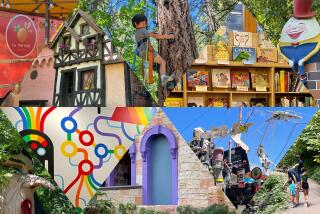Hints for Creating a Successful Outing
- Share via
As Michael Alexander put it, “Remember you’re taking children, not short adults, to a performance. If you’re going to take kids, it’s helpful to think things through first. As a courtesy to others around you, be prepared to respond when your child isn’t behaving.”
PLAN AHEAD
--Call the box office first. Ask specific information about the program to see if it’s appropriate for children. Even if it’s an art exhibit, ask if it’s scary or suggestive. Other things that rate high are lots of activity in the performance and colorful costumes or scenery.
If you’re not satisfied with the answers from the box office, ask for the program director or manager.
--Remember that you’re sharing experiences, so talk about the event beforehand. Let the children know what they might expect--what to look and listen for. Show them pictures of the paintings you’re going to see; play the music or soundtrack. You might even get a video to familiarize them with the performance.
--Be specific about good manners. Remind them they must sit still and be quiet. If they must say something--whisper.
--At an art museum, remind them that the works are precious and that they were made by someone else who cared for them very much.
--Know the theater. Most important, know where your seats are. Being surprised that your seats are in the back row of the balcony and that your 6-year-old can’t see is not a great way to start.
YOU’VE ARRIVED
--Use the bathroom before the show.
--Use intermission effectively--get drinks of water, eat a snack. Use this time to talk and answer questions. Give them more things to think about for the second half. If time and weather permit, let them run off some energy outside.
KEEPING THEIR INTEREST
--Dance
Have them watch the men lift the women dancers to see the strength involved in dance. Ask them if they think the movements go with the music. Ask them if they’d create the dance the same way.
--Concerts and Theater
Try to have them listen for individual instruments in the orchestra--flutes, violins, drums. Have them think about the rhythm. Have them watch for the movements of the conductor--how does he get each instrument to join in, to stop, to play louder or softer.
--Art Museums
Here are a variety of questions you can ask your children that gallery teachers often ask. Tell them to “walk into the picture” and tell you what it feels like--is it cold, rainy, windy, warm? If there are people, what are they doing, why are the doing it, what might they feel like (are they happy or sad)?. Ask them how the painter used color to get those ideas across. What is the center of interest and why?.
You can also get them to focus on one object, a tree, for example, and have them tell you all the colors they see within the green leaves.
The most important thing to remember about any family adventure is not to expect too much from your children. It’s not failure if they can’t get past the first act or the first painting.
More to Read
The biggest entertainment stories
Get our big stories about Hollywood, film, television, music, arts, culture and more right in your inbox as soon as they publish.
You may occasionally receive promotional content from the Los Angeles Times.










